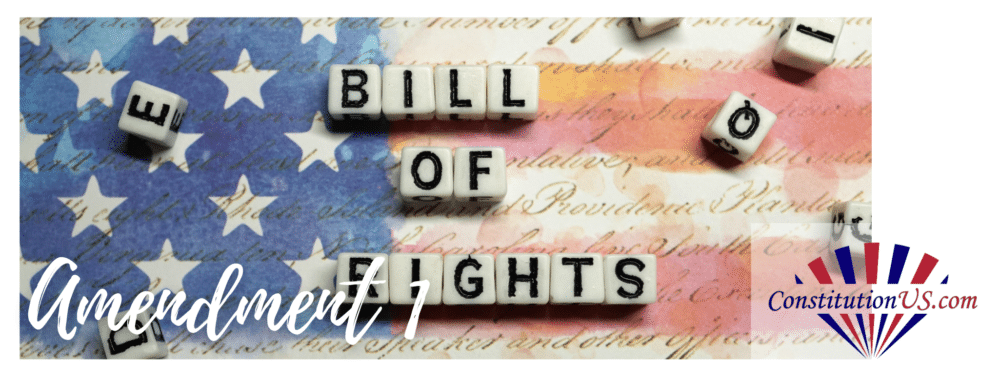What Exactly is the Bill of Rights?
While it may, at first glance, seem like its own separate document, similar to the Declaration of Independence, the Bill of Rights is the first 10 amendments added to the United States Constitution. Initially written to help ensure the ratification of the Constitution, the Bill of Rights act as established guarantees for the American people regarding their rights and freedoms. Vital freedoms, such as the freedom of speech, freedom of religion, right to bear arms, or protection against illegal search and seizure, are all given to the country’s citizens to ensure their protection and liberties against any potential overreach performed by the federal government.
Below, we are going to go over what is included in the Bill of Rights as well as everything that went into its creation.
The Bill of Rights Summarized
The First Amendment
The First Amendment offers the American people freedom to express their ideas through speech and the press. It also protects their rights to assemble or gather within a group. It allows Americans to protest their government and petition them for a redress of grievances (i.e., to speak to your representative about an issue).
Finally, the First Amendment protects any and all religious beliefs, expressions, and practices while also preventing the government from establishing or unduly favoring any particular religion.
While the reason for the First Amendment may seem somewhat obvious today, at the time, it was seen as vitally important. Under British rule, the government did not allow any dissenting speech against the Church or the King. Similarly, the practice of any religion outside of Christianity was considered treason and heresy.
The Second Amendment
The Second Amendment is considered to be the method by which the First Amendment is actively protected. It says that to ensure the security of a free state, people should have the right to keep and bear arms to form a “well regulated militia.”
Despite seeming fairly clear, this amendment has been open to many interpretations, particularly based on a person’s specific view as it relates to gun control. Those that are against any type of regulation cite the amendment’s statement that the right to bear arms “shall not be infringed.”
Conversely, those that feel gun safety is essential and that there should be some level of regulation have cited the amendment’s line stating that only a “well-regulated militia” should own weapons and that those weapons should be “well regulated.”
While many have argued that the Second Amendment allows guns for hunting or self-protection, neither reason is included. Instead, it very clearly entails using arms for “the security of a free state.”
The Third Amendment
The Third Amendment is not nearly as contested as the others on this list, primarily due to the fact that it has never been a requirement. It states that soldiers are forbidden from forcible housing (or “quartering”) themselves in an American citizen’s home. This is particularly true during “peacetimes” but also holds weight during times of war, where it must be, at that time, “prescribed by law.”
While the US has never found this amendment particularly controversial, the reason for its inclusion is likely due to the “Quartering Act of 1765.” This parliamentary act essentially forced the colonials to house and provide food, fuel, drink, and transportation to the British forces stationed in their respective towns and villages.
By enacting this Amendment, American citizens would not be forcibly subjected to this for any other reason outside of express wartime, and only after a law was put into place.
The Fourth Amendment
The Fourth Amendment is argued to potentially have one of the more numerous interpretations surrounding it, mainly based on where you stand surrounding policing and privacy. It states that people have the right to be secure in their own homes and effects and are protected against unreasonable or illegal search and seizure outside of probable cause.
Because of this amendment, specific things such as search warrants, safety inspections, and “stop-and-frisk” laws are implemented throughout the country. Many have also argued that certain things like wiretapping and other forms of surveillance are violations of the Fourth Amendment, as it is difficult to expressly argue probable cause.
The Fifth Amendment
The Fifth Amendment is one of the most essential rights given to the American people and deals entirely with our legal justice system. It states that no person shall be tried for the same crime twice, be made to implicate themselves in a crime, or be sent to prison without due process. It also states that Americans have a right to a grand jury and that the government directly compensates for the public use of one’s private property.

As with many of these Amendments, this was largely due to fear of a government “throwing away” anyone determined to be “guilty” even before having an actual trial. Similarly, this amendment ensured that a person would neither perjure nor implicate themselves if put on trial.
The Sixth Amendment
Seen as a follow-up to the Fifth Amendment, the Sixth Amendment goes further by stating that all Americans are guaranteed the right to a speedy trial. They are also guaranteed the right to a jury and a right to face their accuser and to a “counsel” (i.e., an attorney).
This amendment is very important as an addition to the Fifth. It ensures the judicial system cannot stretch court case dates indefinitely, essentially causing a person to wait in jail or prison for years and years between respective trials. It was also vital, as it ensured that an accused could face the person that accused them, potentially as an attempt to hide against false accusations. Finally, it gave those accused the right to counsel or attorney, ensuring that they could properly have their case argued in court.
The amendment also ensured that they would be given a trial in front of a jury of their peers. This assured that they would get a fair verdict rather than an unjust verdict that could potentially come from the political elite or strictly from the judge’s decision.
The Seventh Amendment
The Seventh Amendment follows after the Fifth and Sixth, dealing primarily with common lawsuits rather than criminal. Today referred to as “civil suits,” the amendment states that, so long as the value of the common lawsuit was over twenty dollars, the accused was entitled to a jury.

This amendment is only slightly controversial, as there is some question on exactly how much twenty dollars is meant to be valued. Whereas some argue that the Amendment stands so long as it is twenty dollars. On the other hand, others contend that, due to inflation, twenty dollars at the time is at least worth over $560 today, meaning that that is the minimum required for a jury.
Currently, most proceedings decide not to recognize this inclusion. Particularly under federal law, cases must have a monetary value of over $75,000 for them to be heard in federal court. Civil cases that end in federal court may require the Twenty Dollar clause, though it does seem to depend on the situation.
The Eighth Amendment
The Eighth Amendment specifically deals with the protection against excessive bail, fines, or cruel & unusual punishment. Like the Fifth Amendment, the Eighth Amendment is meant to protect the American people from a particularly vindictive or cruel judicial system.
The basis of the Eighth Amendment seems largely inspired by the English case of Titus Oates in 1685. After being convicted on multiple acts of perjury, Oates was forced to undergo an annual whipping while tied to a moving cart throughout his prison sentence. This topic, along with many other different sentencings, was considered “barbaric, excessive, and bizarre.”
While there is still contention on whether capital punishment can be defined as “cruel and unusual punishment,” it has been struck down by the Supreme Court for virtually all cases outside of murder convictions.
The Ninth Amendment
The Ninth Amendment is considered as somewhat of a “catch-all” in relation to any and all instances where the Constitution does not directly reference (or “enumerate”) a specific right given its people. This essentially means that, even if not directly referenced in the Bill of Rights or the Constitution, people were still protected by – what many consider to be – “unenumerated” rights.
As an example, while the Bill of Rights does not expressly give people the right to keep their possessions, it is assumed that they have a right to their possessions. As the author of the Bill of Rights, James Madison drafted this amendment with the understanding that, over time, others in government would potentially seek to find ways to oppress the people still, even while “honoring” the aforementioned amendment rights. This was his attempt to guard against that.
The Tenth Amendment
Meant as a way to further restrict the federal government as much as possible, the Tenth Amendment states that it is only given the powers directly allocated to it by the Constitution. It also says that any powers not expressly prohibited to the states, or expressly given to the federal government, are awarded and reserved to the states or the people.

Get Smarter on US News, History, and the Constitution
Join the thousands of fellow patriots who rely on our 5-minute newsletter to stay informed on the key events and trends that shaped our nation's past and continue to shape its present.
This amendment was used to properly establish the dividing line between State and Federal government. Things like the federal ability to tax, police, and regulate commerce, are intrinsic to them, whereas anything not expressly included in the Constitution is either power given to the state government or the people of the country itself.
Why was the Bill of Rights Needed?
The Articles of Confederation & the Birth of the US Constitution
Between 1781 and 1788, America did not follow or have the US Constitution as its governmental body structure. Instead, it acted under the Articles of Confederation, a well-intentioned if an ultimately ineffectual form of government. Seeing a strong centralized government as being the very thing they were (quite literally) fleeing and at war against, the Continental Congress wanted the country to give each state their rights and powers. At the same time, leaving the federal government enough powers to either pass or amend laws as well as request funds from the individual states.

Unfortunately, this resulted in a centralized government that was virtually useless. It could not raise taxes, regulate trade, establish or maintain an armed defense, or easily create universal laws across every state. As such, it was because of this weak government that many realized that the country as a whole would not prosper and could even devolve into anarchy.
Thus, the need for a newly revised government structure was devised, known as the US Constitution.
Opposition to the Constitution & the Need for the Bill of Rights
However, while many states saw the need for a new Constitution, many other states violently opposed the idea of a Constitution, regarding it as a massive overreach by those in favor as well as ultimately slipping the country back into the very tyranny they had escaped. Many critics of the Constitution, known as Anti-Federalists, included the outspoken Patrick Henry and Melancton Smith, Samuel Bryan, Robert Yates, George Clinton, and many other small farmers, shopkeepers, landowners, and laborers.
These Anti-Federalists argued that, under the Constitution, the president would simply be a pseudo king. Congress may seize many powers under the guise of “necessary and proper” reasons. The federal government would simply gain too much power at the expense of the individual states. Their most biting critique of the Constitution was its lack of a bill of rights, leaving people subject to almost any governmental overreach put upon them.
Understanding its importance, the Federalists promised to amend the Constitution upon its ratification. James Madison introduced twelve amendments in 1789, of which ten were ratified. At this point, these ten amendments were collectively known as the US Bill of Rights.




